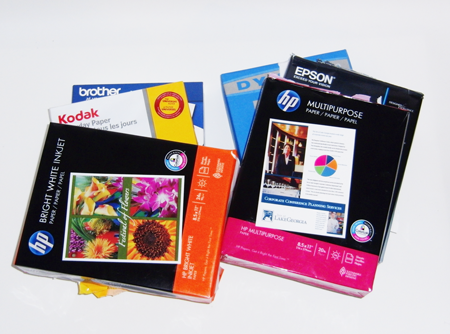Tom's Hardware Benchmarks Inkjet Printer Paper!
Everyday Printing
Many of us print off pages of email, school projects, packing slips, and invoices every single day. It's one of those almost-ironic relics of a world before everything started going digital.
But we're not here to debate the ramifications of burning through trees. No, we're wondering how the quality of the paper you do use affects what comes out the business end of your printer. You probably sunk a lot of time into researching the right printer to buy, but did you consider that your paper of choice matters as well?
The texture and composition of paper play a big role in output quality. When copy machines print on standard office paper, the paper doesn’t get wet. However, the composition of cheap office paper is too weak to work well with inkjet printers because ink tends to pool around the point of contact (printer head) and wick through the paper's fibers. The result is a piece of paper in which ink seeps along the fibers, creating miniature spider web-like patterns.
Inkjet paper is specifically different because it's made using a high-quality chemical-based manufacturing process. The goal of this process is to produce a paper with the right degree of absorbency to accept ink, while preventing it from wicking sideways. That's why inkjet paper tends to be heavier, brighter, and smoother than copy paper.
Ultimately, you need to understand that there are three major factors in paper quality: absorbency, brightness, and weight. Photographers often have their personal favorites when it comes to photo paper, which benefits from chemical coats that change how ink behaves once it hits the paper, but this isn't what we use on a day-to-day basis. We do know that matte paper is cheaper, but what makes the paper of one brand different from another?
In order to find out how paper affects the quality of your everyday printing tasks, we're testing six different reams of paper, with 500 pages per ream.
| Price | $6.99 | $4.99 | $8.99 | $10.99 | $6.99 | $8.99 |
|---|---|---|---|---|---|---|
| Brand | Brother | Dynex | Epson | HP | HP | Kodak |
| Type | Multipurpose | Multipurpose | Bright White | Bright White | Multipurpose | Everyday |
| Brightness (ISO) | 96 | 92 | 96 | 97 | 96 | 96 |
| Weight (lb.) | 20 | 20 | 24 | 24 | 20 | 20 |
Get Tom's Hardware's best news and in-depth reviews, straight to your inbox.
